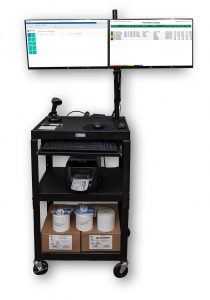Real-time data that drives real-time decisions
Profile:
- 90-day ROI
- 15 Workstations with dual-monitors
- 2,700 labor hours saved per month
- A 100-employee manufacturer of emergency vehicles based in Iowa.
Challenge:
The manufacturer used Global Shop Solutions’ ERP software to track tasks such as work orders
in progress, job costing and shop floor efficiency. Still, it couldn’t respond quickly enough to the
data to hold shop workers accountable because data was often input manually after a job was
completed.
Solutions:
The company used Global Shop TrueView to display critical data points and reports from its ERP
system, refreshed every two minutes. It implemented 15 workstations complete with
computers, barcode scanner, and dual-monitors placed at various locations throughout its
facility for its laborers and managers to see job-related data regularly.
Benefits: Within 90 days, the ambulance manufacturer saw an average 12% efficiency gain
within each work cell, resulting in a labor savings of more than 2,700 hours per month.
The Manufacturer’s Dilemma: Do More with Less
In nearly every market, it’s understood that the price of goods and services will go up over time.
While this may sound like common sense to some, it’s not how things work in manufacturing.
With few exceptions, manufacturers are expected to maintain consistent pricing. Brady Robbins
was the former systems administrator for a 100-employee emergency vehicle manufacturer,
and he can attest to this truth. “I recall one year that the cost of aluminum went up
significantly, which would have resulted in a $1,000 increase in ambulances,” he says. “But, we
had to find ways to lower our expenses in other areas to offset the increase to keep the cost
level.”
Besides comparison shopping for less expensive raw materials, operational efficiencies are one
of the primary ways manufacturers keep their costs down, and Robbins’ company was no
exception. Because the manufacturer wasn’t just making parts — it was building completed
emergency vehicles — dozens of work cells had to work together to coordinate each step of the
assembly process. “Plus, each emergency vehicle is highly customized from the fabric types and
colors to the interior and exterior lighting, stretchers, and other equipment.”
You Can’t Take Action on Old Data
And we needed to present timely information to shop floor managers and laborers in their work environments.
Although the manufacturer used Global Shops ERP, there was a significant lag time in its data
input. Typically, workers would write down information on paper and pass it along to the next
person in the machining or assembly process. Only at the end of the process was all the
information entered into the ERP system and displayed in the Global Shop TruView dashboard.
As a result, there wasn’t any timely feedback or accountability among workers, says Robbins. By
the time a shop floor manager reviewed a report and noticed a job took longer than projected
to complete, it was too late to confront the workers and determine the root cause of the
problem. “We needed a way to present data much sooner,” says Robbins. “And we needed to
present timely information to shop floor managers and laborers in their work environments.”
The Real-Time Data Solution – a Web-Enabled Mobile Workstation
 Robbins implemented a multipart solution to address the company’s challenges. “The first part
Robbins implemented a multipart solution to address the company’s challenges. “The first part
entailed creating a dashboard that presented a customized view from TruView. This enabled
workers and managers to see works in progress, job costing estimates, and other key data
points associated with their respective departments,” he says. “The next step involved creating
mobile workstations that enabled workers to input data.” Each workstation comprises Wi-Fi-
enabled computers connected to dual-monitors.
Timely Data Creates Healthy Competition, Better Accountability
Every department saw an average 12% increase in efficiency, which resulted in monthly labor savings of more than 2,700 hours, which is nearly 33,000 hours a year
Despite initial skepticism and resistance among some workers who didn’t see the necessity of
the workstations, attitudes began changing within the first month, says Robbins. “Employees
and managers started looking at the monitors regularly to see how their department was
trending compared to other departments,” he says. “One of the nice things about the displays
is that they don’t just show rows of numbers, but they also incorporate color. So, for example, if
a job is falling behind, the row turns red, which enables a manager to spot it and work to
correct the problem quickly.”
After 90 days of using the mobile workstations, the company assessed shop floor job
performance. “Every department saw an average 12% increase in efficiency, which resulted in
monthly labor savings of more than 2,700 hours, which is nearly 33,000 hours a year,” says
Robbins. What’s remarkable about this story is that it wasn’t about making massive changes to
our manufacturing or assembly processes. It was about enabling our shop floor workers and
managers to input and access real-time data and empowering them to make the necessary
changes to work more efficiently.”
For more information, call us at 972-535-5555 or get a free consultation by clicking here.

